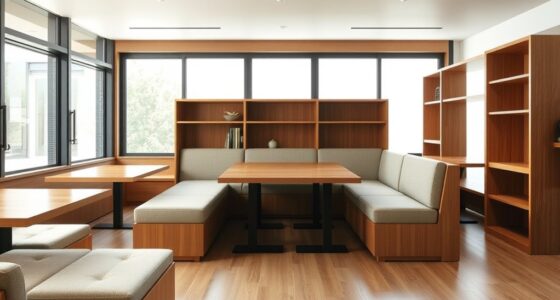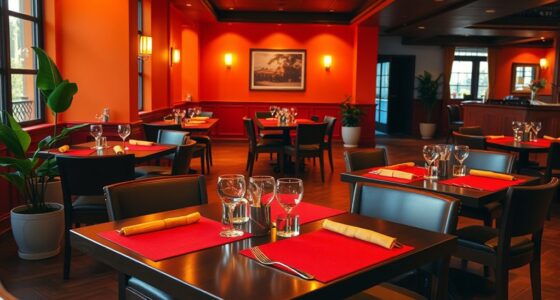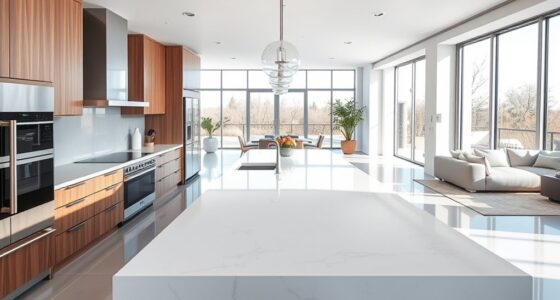To incorporate biophilic design in your restaurant, maximize natural light with large windows, skylights, and open layouts. Add greenery like plant walls and indoor plants to boost ambiance and air quality. Use natural materials such as wood, stone, and woven fibers for furniture and decor. Design with outdoor views in mind, and include water features for a calming atmosphere. Enhance space with natural textures and biophilic lighting—continue to discover even more ideas to create a truly inviting environment.
Key Takeaways
- Incorporate large windows, glass doors, and skylights to maximize natural light and create seamless indoor-outdoor connections.
- Use indoor greenery, plant walls, water features, and natural materials like wood and stone to evoke outdoor elements.
- Design seating to face scenic views and maintain clear sightlines to enhance the connection with nature.
- Apply natural textures and earthy tones, layering different materials to create a calming, nature-inspired atmosphere.
- Utilize biophilic lighting techniques, including tunable and indirect lighting, to mimic natural light cycles and enhance ambiance.
Maximizing Natural Light to Brighten Dining Areas
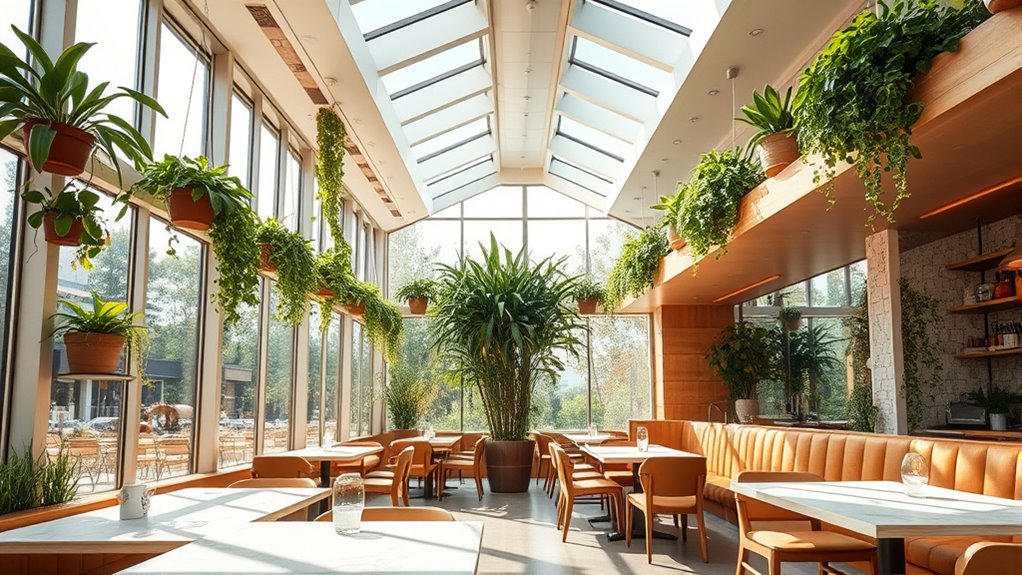
Maximizing natural light is essential for creating inviting and vibrant dining spaces. When you let sunlight flood your restaurant, it naturally enhances the atmosphere, making guests feel more comfortable and relaxed. Use large windows, glass doors, or skylights to bring in as much daylight as possible. Keep window treatments minimal to avoid blocking light, and consider reflective surfaces like light-colored walls and polished floors to bounce sunlight around. Position tables near windows to give diners a bright, cheerful experience. Avoid heavy drapes or dark curtains that reduce light. Remember, daylight not only improves mood but also reduces the need for artificial lighting, lowering energy costs. By thoughtfully maximizing natural light, you create a lively, welcoming environment that encourages guests to linger. Regularly assessing and rotate items can help maintain a clutter-free space that allows light to flow freely throughout the restaurant.
Incorporating Indoor Greenery and Plant Walls
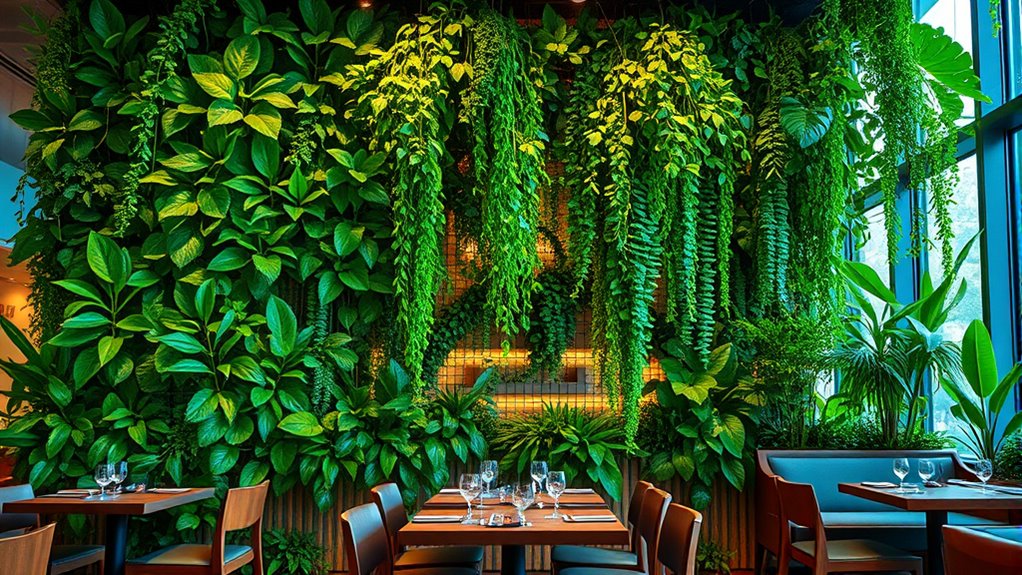
Building on the benefits of natural light, adding indoor greenery and plant walls can considerably enhance your restaurant’s atmosphere. Greenery introduces vibrant, calming visuals that can reduce stress and boost customer satisfaction. Plant walls, whether filled with lush ferns, succulents, or moss, create striking focal points that connect diners with nature. They improve air quality by filtering pollutants, making your space healthier and more inviting. You can use a variety of plants suited to indoor conditions, ensuring low maintenance and longevity. Position these green elements strategically near entryways, dining areas, or behind the bar to maximize visual impact. Incorporating greenery not only elevates your restaurant’s aesthetic but also fosters a relaxing environment that encourages patrons to linger. Be mindful of indoor air quality considerations when selecting and maintaining your plant displays.
Using Organic and Natural Materials in Furniture and Decor
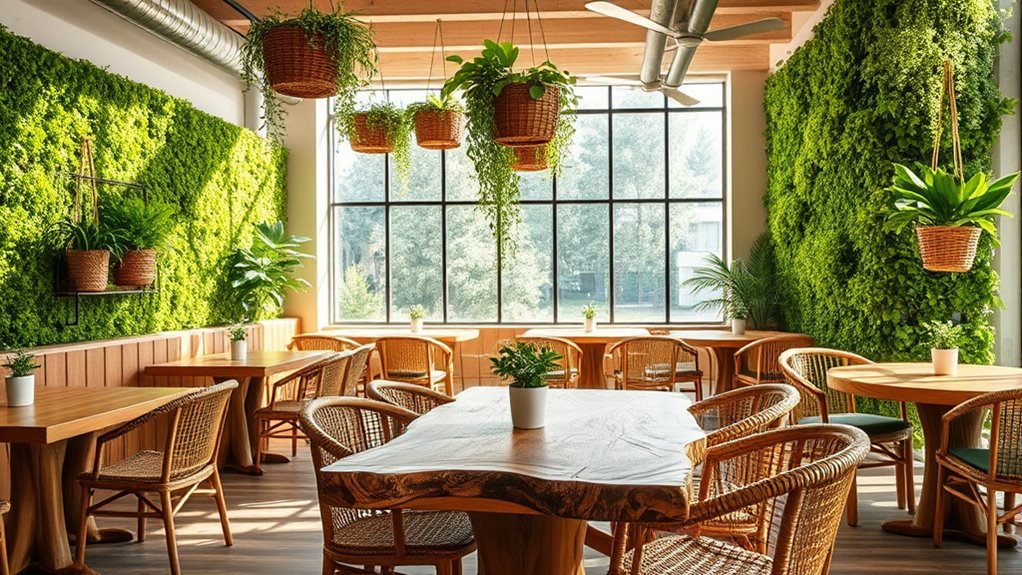
Incorporating organic and natural materials into your restaurant’s furniture and decor instantly creates a warm, authentic atmosphere that resonates with guests. Use wood, cork, bamboo, or reclaimed materials to craft tables, chairs, and accents that highlight nature’s textures. These materials add visual warmth and tactile appeal, making your space feel inviting and grounded. Incorporate textiles like linen, jute, or hemp for upholstery, curtains, or table runners to enhance the natural vibe. Avoid overly polished or synthetic finishes; instead, opt for raw, unfinished, or weathered surfaces that emphasize authenticity. Natural materials also age gracefully, developing character over time. By choosing eco-friendly and sustainably sourced options, you reinforce your commitment to environmental consciousness, creating a memorable dining experience that connects guests with the natural world. Additionally, selecting sustainable building materials can further improve your restaurant’s eco-friendliness and appeal to environmentally conscious diners.
Designing With Views of the Outdoors in Mind
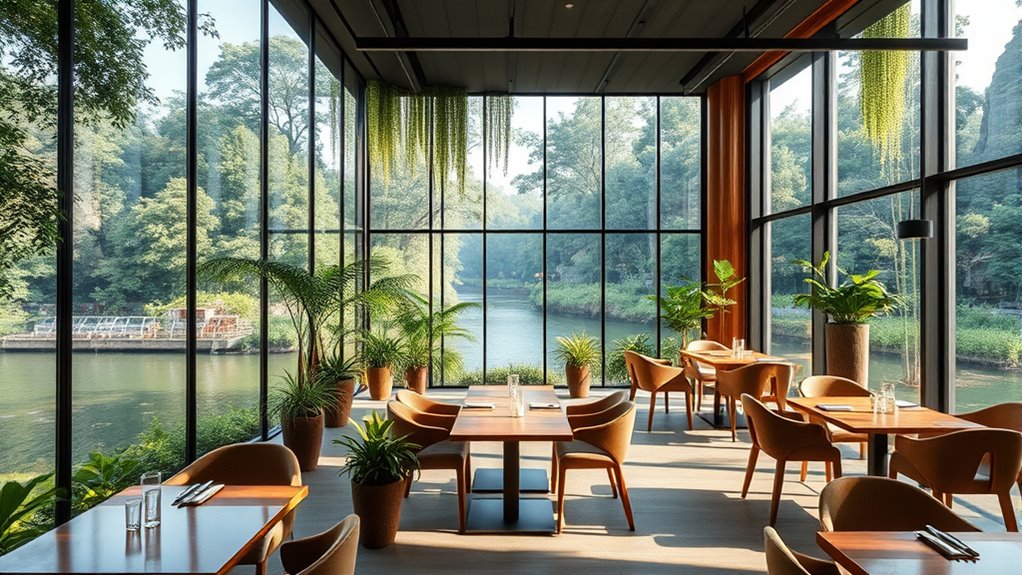
Using natural and organic materials in your restaurant’s design naturally complements outdoor views, creating a seamless connection between inside and out. Large windows, glass walls, or open layouts allow diners to immerse themselves in the surrounding scenery. Position seating to face windows or outdoor vistas, encouraging guests to enjoy the landscape. Incorporate elements like planters, green walls, or natural textures that echo the outdoor environment. Use earthy tones and materials such as wood, stone, or bamboo to reflect the natural landscape outside. Keep sightlines clear and unobstructed, ensuring views remain the focal point. These design choices foster a calming atmosphere, making diners feel more connected to nature and enhancing their overall experience. Prioritizing outdoor views turns your restaurant into a tranquil retreat. Additionally, understanding the importance of emotional support can help create a welcoming environment that promotes relaxation and well-being for your guests.
Creating Water Features for a Calming Atmosphere
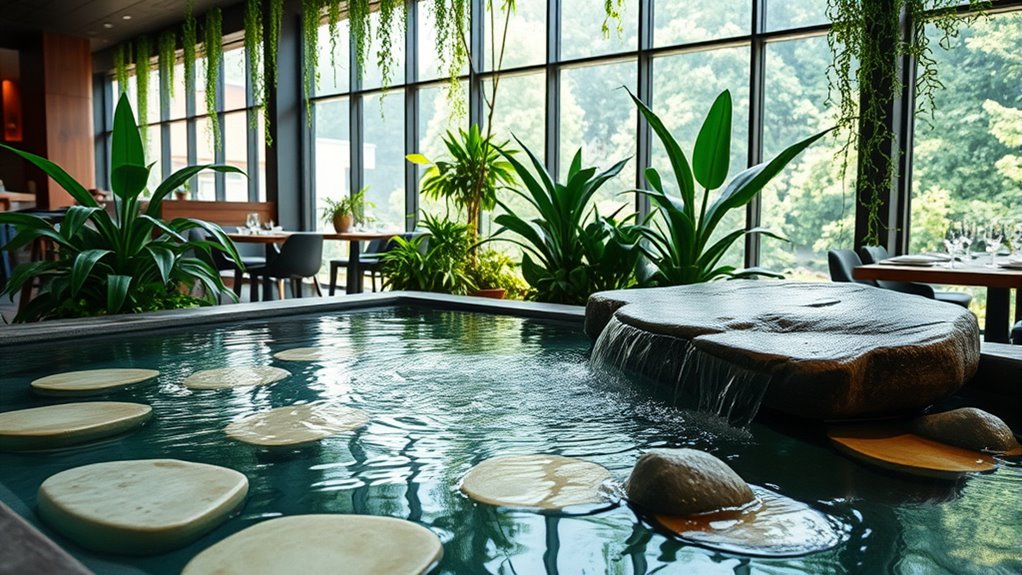
Adding water features can instantly create a calming atmosphere in your restaurant. The gentle sounds of tranquil water and natural water elements help guests relax and feel more at ease. Incorporating these features thoughtfully enhances your space’s overall sense of tranquility. For example, a natural water feature can serve as a focal point that complements your biophilic design.
Tranquil Water Sounds
Water features can markedly enhance the ambiance of a restaurant by introducing soothing, natural sounds that promote relaxation. The gentle flow of water creates an auditory backdrop that calms your guests and masks background noise, making conversations more intimate. You might consider installing a small fountain or a bubbling stone feature, which produces consistent, tranquil sounds without overwhelming the space. Position these features strategically to maximize their calming effects while maintaining visual appeal. The sound of water can also evoke a sense of serenity and connection to nature, enriching your overall design. Incorporating natural materials such as stone and wood in the water feature can further enhance the authentic, calming atmosphere. Keep the volume gentle and natural, avoiding loud or abrupt sounds that could disrupt the peaceful environment you’re cultivating. Tranquil water sounds are a simple yet powerful way to foster a calming restaurant atmosphere.
Natural Water Elements
Incorporating natural water elements into your restaurant’s design creates a soothing and inviting atmosphere. Adding features like small fountains, waterfalls, or rippling ponds introduces gentle movement and calming sounds that enhance the dining experience. You can position a water feature near the entrance to immediately set a relaxed tone or create cozy nooks with mini waterfalls for intimate spaces. Use natural materials such as stones, bamboo, or wood to complement the water and reinforce a connection to nature. Guarantee the water is clean and well-maintained to prevent odors or algae growth. Subtle lighting can highlight water features at night, creating a warm, welcoming glow. These elements not only improve aesthetics but also foster a sense of tranquility, encouraging guests to linger and enjoy their meal. Maintaining water quality is essential to ensure a healthy and serene environment for your patrons.
Integrating Earth Tones and Textures Into Interior Design
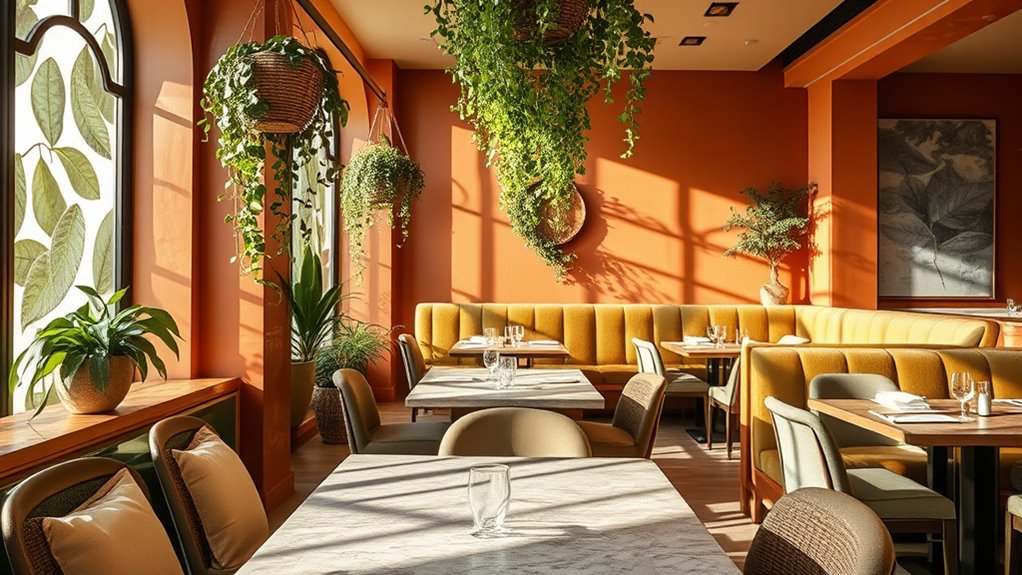
You can create a cozy, inviting atmosphere by choosing a warm earth color palette that feels natural and calming. Incorporate nature-inspired textures like wood, stone, or woven fabrics to add depth and tactile interest. Combining these materials thoughtfully enhances harmony and reinforces a connection to the environment. Additionally, integrating Free Floating elements can introduce a sense of openness and fluidity, further enriching the natural aesthetic.
Warm Earth Color Palette
A warm earth color palette brings a soothing and inviting atmosphere to restaurant interiors by blending natural tones and textures. Think rich browns, gentle terracottas, soft beiges, and muted greens that evoke the outdoors. These colors create a sense of comfort and stability, making guests feel relaxed and at home. Incorporate these hues through painted walls, furniture, and decorative accents to foster a cohesive, nature-inspired environment. Using warm earth tones also enhances the perception of natural materials like wood and stone, reinforcing the biophilic connection. Keep the palette balanced to avoid overwhelming the space—pair darker shades with lighter neutrals for harmony. Additionally, understanding the history of pinball machines can inspire vintage-inspired design elements that add nostalgic charm to the space. Overall, this color approach helps you craft a welcoming setting that resonates with natural serenity and encourages diners to linger longer.
Nature-Inspired Textures
To create a truly immersive biophilic restaurant environment, integrating natural textures that complement earth tones is essential. You can achieve this by incorporating materials like reclaimed wood, stone, and woven fibers into your design. These textures evoke the outdoors, grounding your space in nature and adding tactile warmth. Mixing rough and smooth surfaces creates visual interest and invites touch, enhancing guest experience. Use the table below for ideas:
| Material | Texture | Earth Tone Example |
|---|---|---|
| Reclaimed Wood | Rough, organic | Warm brown |
| Stone | Cool, rugged | Soft gray |
| Woven Fibers | Soft, textured | Sandy beige |
Balancing these textures connects your guests with nature, fostering a calming, authentic atmosphere. Incorporating sound vibrations through ambient music or subtle sound frequencies can further deepen the natural ambiance of your space.
Harmonious Material Combinations
Integrating natural textures with carefully chosen earth tones creates a cohesive and inviting interior that celebrates the beauty of nature. When you combine warm browns, muted greens, and soft beiges with materials like wood, stone, and clay, you craft a space that feels grounded and harmonious. This balance enhances the overall atmosphere, making your restaurant feel both comfortable and authentic. To achieve this, consider pairing rough-hewn wooden tables with smooth stone accents or textured fabric upholstery in earthy hues. These combinations not only evoke a sense of calm but also connect diners to nature subtly. By thoughtfully blending textures and tones, you create a space that’s visually appealing and emotionally restorative.
- Use contrasting textures like rough wood and smooth ceramics
- Layer different earth tones for depth
- Incorporate natural materials such as stone, clay, and wood
Utilizing Natural Ventilation and Air Flow
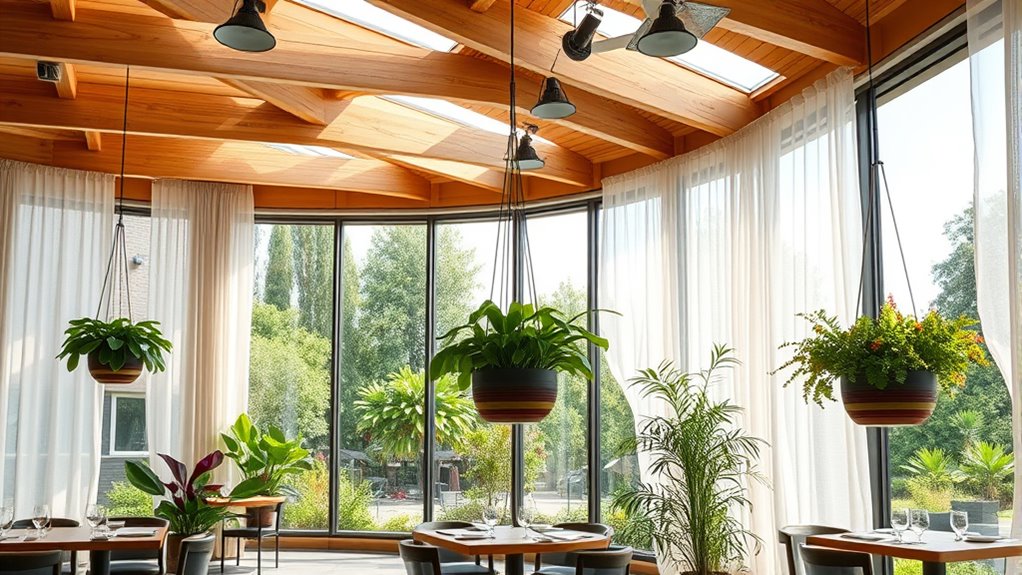
Have you ever noticed how natural airflow can transform a restaurant’s atmosphere? When you incorporate open windows, vents, and strategically placed openings, you create a fresh, inviting environment. By harnessing cross-ventilation, you allow cool breezes to flow through the space, reducing the need for artificial cooling. This not only enhances comfort but also promotes better air quality. Position seating and kitchen areas to optimize airflow, and consider using operable windows or vents that can be easily adjusted. Using natural ventilation can lower energy costs and provide a more sustainable dining experience. Remember, the goal is to create a seamless connection between indoor and outdoor environments, making your restaurant feel more lively and welcoming through effective air flow management.
Implementing Biophilic Lighting Techniques
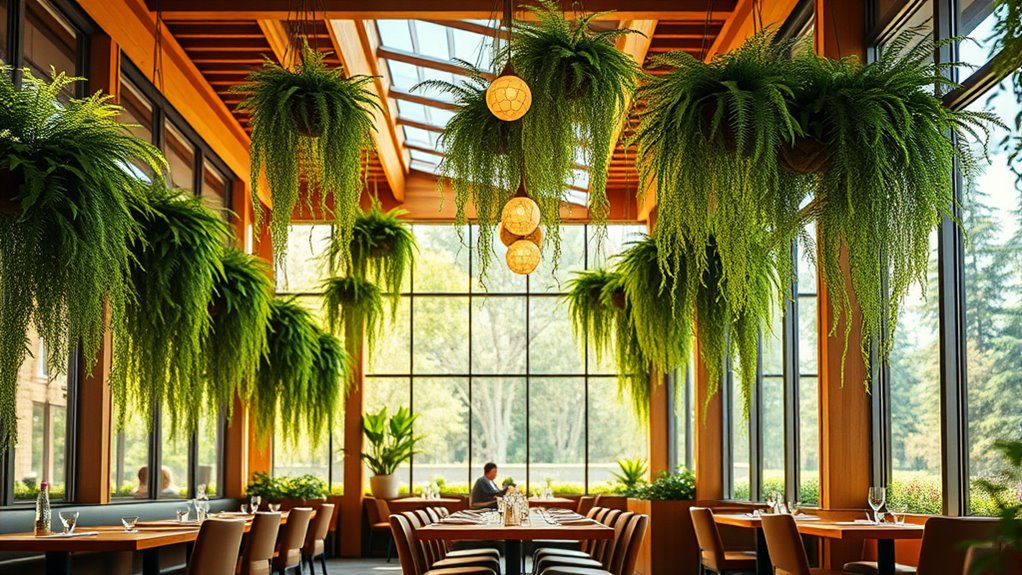
Implementing biophilic lighting techniques can dramatically enhance your restaurant’s ambiance by connecting interior spaces with natural light. You can achieve this by maximizing daylight with large windows, skylights, or glass doors that invite sunlight indoors. Use tunable lighting systems that adjust color temperature throughout the day, mimicking natural light patterns to create a comfortable atmosphere. Incorporate indirect lighting to reduce glare and distribute light evenly, making spaces feel warmer and more inviting. Dimming controls allow you to set the mood for different times and occasions, enhancing guest experience.
- Maximize daylight with large windows or skylights
- Use tunable lighting to mimic natural light cycles
- Incorporate dimming controls for mood adjustments
Adding Elements of Nature Through Art and Decor
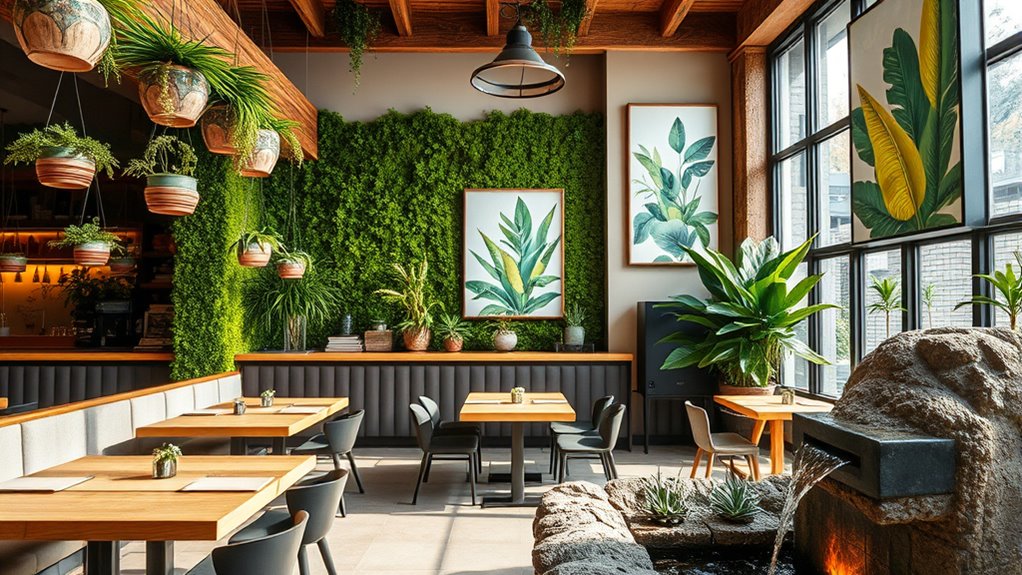
You can enhance your restaurant’s natural feel by incorporating artistic displays of nature that catch the eye. Adding accents made from natural materials like wood, stone, or woven fibers further connects guests to the outdoors. These elements create a welcoming, calming atmosphere that highlights your commitment to biophilic design.
Artistic Nature Displays
Artistic nature displays bring the outdoors inside by incorporating natural elements through art and decor, creating a calming and immersive environment. These displays can evoke a sense of tranquility and connection to nature without physical elements. You might use murals of lush forests or serene landscapes to set a peaceful tone. Sculptures inspired by organic shapes add depth and visual interest. Incorporating botanical illustrations or framed photographs of natural scenes enhances the ambiance subtly.
To maximize their impact:
- Choose artwork that reflects local flora and fauna for authenticity.
- Use natural colors and textures to complement the overall design.
- Rotate or update displays seasonally to keep the environment fresh and engaging.
Natural Material Accents
Building on the calming effect of nature-inspired artwork, incorporating natural material accents introduces tangible elements of the outdoors into your restaurant’s decor. Think exposed wooden beams, stone countertops, or bamboo accents that highlight raw textures and organic forms. These materials create a warm, inviting atmosphere and foster a sense of authenticity. Use reclaimed wood for tables or wall panels to add character and sustainability. Incorporate woven baskets, jute rugs, or cork accents to enhance the tactile experience. Natural materials not only elevate aesthetic appeal but also promote a connection to nature, making diners feel more relaxed and at ease. By thoughtfully integrating these elements, you create a space that feels both grounded and harmonious with the environment.
Crafting Outdoor Seating and Patio Spaces
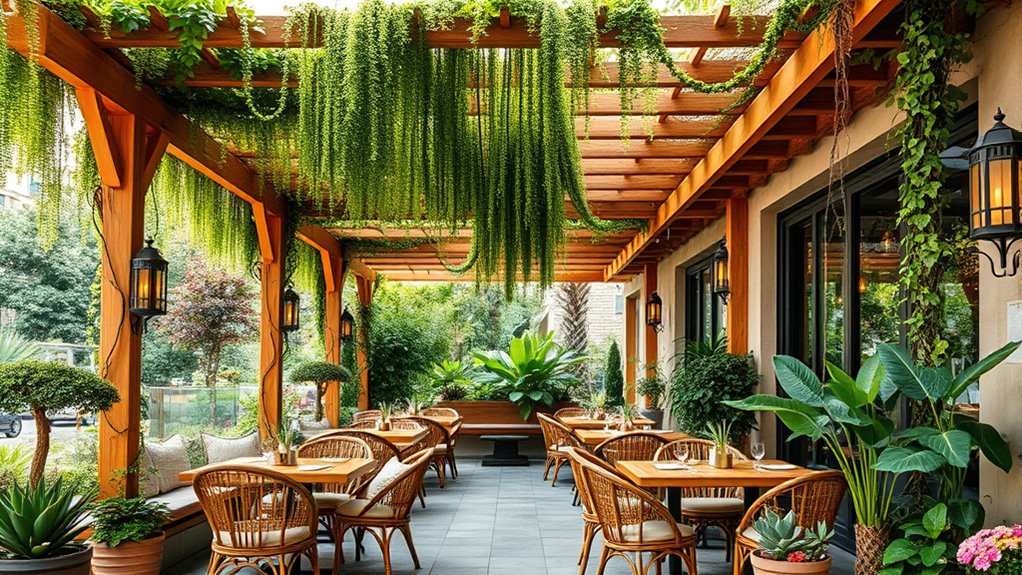
Designing outdoor seating and patio spaces with biophilic principles involves integrating natural elements that foster a sense of connection to nature. You can achieve this by incorporating greenery, natural materials, and organic shapes to create a welcoming environment. Use lush plantings, such as potted trees or hanging gardens, to soften the space and provide shade. Choose furniture made from wood or rattan to blend seamlessly with the surroundings. Incorporate elements like water features or natural stone to enhance sensory engagement. Consider layout and privacy, using screens or greenery to define areas while maintaining openness. By thoughtfully designing these spaces, you invite customers to relax and reconnect with nature, elevating their dining experience.
- Add diverse plantings for visual interest
- Use eco-friendly, natural materials
- Incorporate water features for sensory appeal
Frequently Asked Questions
How Can Biophilic Design Improve Customer Satisfaction and Retention?
You can boost customer satisfaction and retention by incorporating natural elements into your restaurant. When you introduce greenery, natural light, and organic materials, you create a calming, inviting atmosphere that makes guests feel comfortable and relaxed. These elements foster a sense of connection to nature, encouraging patrons to stay longer and return often. By prioritizing biophilic design, you enhance the overall dining experience, building loyalty and positive word-of-mouth.
What Are Cost-Effective Ways to Incorporate Biophilic Elements Into Existing Restaurant Spaces?
Did you know that incorporating natural elements can boost customer satisfaction by up to 15%? To do this cost-effectively, start by adding plants to your space—think low-maintenance succulents or hanging greenery. Use natural lighting whenever possible, and incorporate earthy tones in your decor. You don’t need a complete overhaul; small, intentional updates like these can create a calming, inviting atmosphere that keeps customers coming back.
How Does Biophilic Design Influence Staff Well-Being and Productivity?
You might wonder how biophilic design impacts staff well-being and productivity. It creates a calming environment, reducing stress and boosting mood, which helps your team stay focused and motivated. Natural elements like plants and sunlight improve air quality and comfort, leading to fewer sick days. As a result, your staff feels more engaged and efficient, ultimately enhancing overall restaurant performance and customer satisfaction.
Are There Specific Plant Species Best Suited for Restaurant Environments?
Imagine a lush oasis amid urban hustle—that’s what choosing the right plants does for your space. You want plants that thrive indoors, like pothos, snake plants, or succulents, which require minimal maintenance and add vibrant greenery. These species purify the air and create a calming atmosphere, making your restaurant more inviting. Focus on low-light, easy-care plants that can handle the busy environment and bring natural beauty to your space.
How Can Biophilic Principles Be Adapted for Small or Limited-Space Restaurants?
You can adapt biophilic principles for small restaurants by maximizing natural elements within limited space. Incorporate vertical gardens or wall-mounted planters to add greenery without sacrificing floor area. Use natural materials, earthy colors, and plenty of natural light to create a calming atmosphere. Small potted plants on tables or shelves also boost biophilic connections. Focus on creating an inviting, nature-inspired ambiance that feels spacious and soothing despite size constraints.
Conclusion
By weaving these biophilic design elements into your restaurant, you create a sanctuary where nature and dining intertwine like a dance. You’ll not only brighten your space and boost guest well-being, but also craft an atmosphere that feels as invigorating as a burst of fresh air. Embrace the beauty of nature indoors, and watch your restaurant flourish into a welcoming oasis where every visit feels like a comforting embrace from the earth itself.



